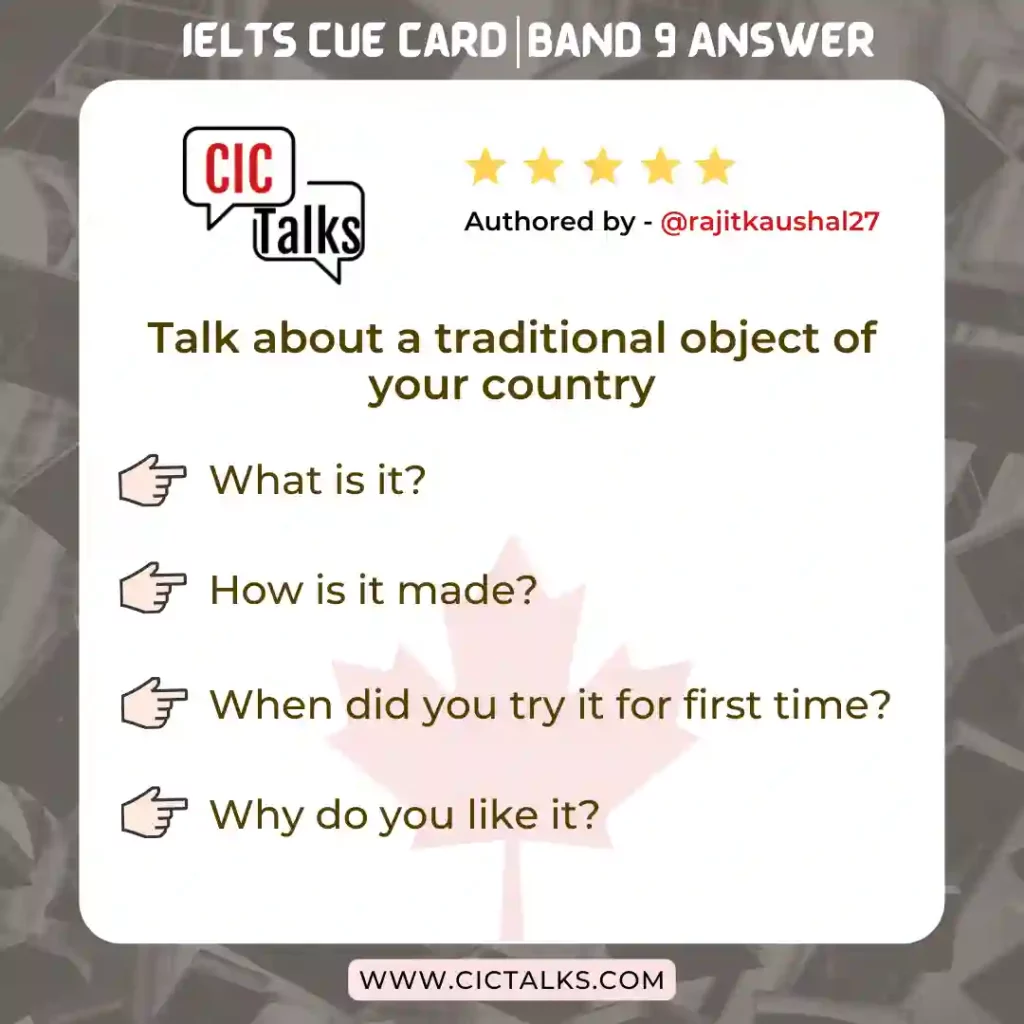[7+] Talk about a traditional object/product of your country that you bought IELTS Cue-Card
In Talk about a traditional object/product of your country that you bought Cue Card, you should say:
- What is it?
- How is it made?
- When did you try it for the first time?
- Why do you like it?

Here are the band 7+ sample answers to Talk about a traditional object/product of your country that you bought IELTS Speaking Cue Card:
Sample Answer 1
Introducing a traditional object/product
- From time immemorial, India is known for its customs.
- As far as traditional products are concerned, India features among the top-rated culturally rich nations in the world.
- So today, I would happily take this opportunity to talk about a traditional object of my country that I bought recently.
What is it?
- The traditional object is the amazing Madhubani painting that I bought from KBA Gallery, Delhi.
- This traditional style of painting can be traced to the Madhubani district in Bihar.
- Literally meaning ‘a forest of honey’, women spend a lot of time making these paintings on the walls of their homes.
How is it made?
- Madhubani is a traditional Indian folk art made on canvas, cloth or paper.
- The paintings were traditionally done on freshly plastered mud walls and floors of huts, but now they are also done on cloth, handmade paper and canvas.
- Natural dye and colours are used in the creation of Madhubani artworks with geometrical figures and vibrant colours being key elements.
- The women use their keen sense of beauty to create evocative paintings of gods and goddesses, animals and characters from mythology, using natural dyes and pigments and painted with the help of twigs, fingers and matchsticks.
When did you try it for the first time?
- I was so impressed with the artwork that I tried to create something like that last Sunday.
- I conceptualized the layout of the painting. Started with the main character and filled it with colours.
- Honestly speaking, there seem to be a lot of things to think about when just beginning to paint.
Why do you like it?
- The thing that I like most about the Madhubani painting is that it depicts people and their association with nature and scenes and deities from the ancient epics.
- Natural objects like the sun, the moon, and religious plants like tulsi are also widely painted, along with scenes from the royal court and social events like weddings.
- Being an avid history lover, these things catch my attention.
Concluding the Cue Card
- The handicrafts of India have been loved and respected worldwide and have left everyone awestruck.
- Through traditional products like Madhubani art, rural people still earn their livelihood and India has still managed to preserve its artisans, its art and its handicrafts.
Sample Answer 2
India has a rich heritage and traditions that are thought to date back thousands of years.
When you travel from North to South or East to West in India, you may encounter a variety of traditional products. But today I’d like to discuss a traditional product from the state of Jammu and Kashmir. This is a Pashmina Shawl. The classic Pashmina is an exceedingly light and delicate textile that is the epitome of beauty, grace, and grandeur.
If you’ve ever seen a genuine pashmina shawl, you’ll want one in your closet. This shawl is unique due to its soft fabric, heavenly feel, and excellent craftsmanship. They provide style, comfort, and a distinct flair to a woman’s wardrobe.
For many years, Pashmina shawls have been among the best traditional apparel pieces for women. Pashmina is a type of wool native to Kashmir. The type of wool utilised to produce these clothing is what distinguishes this fabric. Making them also requires a significant amount of effort. The cost of a pashmina varies according to the quantity of labour involved in its production.
Last winter, I gave it a shot for the first time. It was a lightweight pashmina scarf that I like wearing. So I wore my hair in a perfect bun, fastened it with a gorgeous traditional scarf, and transformed into the diva I’d always wanted to be.
Finally, this is a typical product from my nation that I purchased and holds a special place in my heart.
Follow-ups
Following are the probable Talk about a traditional object/product of your country that you bought follow up questions that may be asked by the examiner in Speaking Part-3 of the test:
1. Describe another traditional product from your country.
India is a land of different cultures, religions, and traditions. The country is also famous for its traditional products such as Terracotta Pottery, Zardozi Embroidery, and Wood Carving. Some of the places to buy genuine Indian handicrafts in Delhi are Dilli Haat, Crafts Museum, and State Emporiums.
2. What are the benefits of traditional products to locals?
The traditional handicrafts bring a lot of benefits to the local community. For instance, these crafts are a major source of income for many people. However, due to industrialization many of our local artisans are facing intense competition. Secondly, these products highlight local culture and folklore and thus connect youngsters to their roots.
3. Do you think the government should help in the promotion of traditional products?
In selling their goods, the government should help the handicraft industry. Promoting Indian art abroad with brand images through seminars and advertising and awareness campaigns in India. The Government should open emporiums for the sale of handicraft goods and shops in towns.
4. Do you think because of globalization countries are adopting each other traditions?
I definitely think so! With globalization, countries are opening doors to new cultures and traditions. It contributes to the expansion of cultural ties between the peoples and human migration. The younger generation learns from each other’s fashion, habits, and preferences.
5. Why do people buy traditional products because of their traditional value or because they are handmade?
I think people buy traditional products nowadays mostly because they are handmade. They wanted to support local artisans and promote their craft. However, this doesn’t mean that the traditional value behind the product is underrated. Some people still look for products that are simply associated with their culture.
6. Did the traditional things of the past have more value than the present things?
The traditional items of the past are mostly handcrafted whereas, the current products are mechanized and manufactured in industries. That’s why the traditional things of the past have more value than the present things.
7. Did the traditional things of the past have better quality than the present things?
For the same reason, the traditional items of the past are mostly handcrafted whereas, the current products are mechanized and manufactured in industries. That’s why present things are more precise and offer better quality than the things of the past.
8. Is it necessary to protect traditions?
It is critical to preserve our cultural history because it protects our identity as a people. The value of intangible cultural legacy is not in the cultural manifestation itself, but in the wealth of information and skills that it passes down from generation to generation.
9. Do you think teenagers should learn about traditions?
Children should absolutely learn their local traditions and folklore. Culture and tradition provide a sense of belonging and comfort, as well as act as an anchor that connects a person to his or her roots. A strong grasp of one’s connection with extended members of the culture helps teenagers in discovering their self-worth.
FAQs
India is a varied nation. In India, there are numerous traditional items. We have earthen pots, Jaipur ceramic pottery, Rajasthan puppets, Punjab phulkari needlework, Srinagar hand-knotted carpets, and much more.
Traditional items keep locals connected to their culture and traditions. They also become a source of income when tourists show interest in and purchase these things.
Certainly, it should. Only if governments promote traditional items will they survive; else, these products, as well as our culture and tradition, would perish.
Yes, as countries become aware of these customs, they adopt them. It is, in some ways, beneficial. Many people celebrate Diwali outside of India as well. We’ve also begun to observe Valentine’s Day, Grandparents’ Day, Father’s Day, and Mother’s Day, among other holidays.
People buy these items for both of these reasons. Handmade items have their unique charm, and only handmade items have true traditional worth. When items are mass-produced by machines, the traditional value of the item is gone.
Of course, yes. We must keep in mind that what we regard as innovative and trendy today will become traditions in the future. As a result, traditional items from the past were different, and as time passes, those items become antiques and hence more expensive.
No, not always. Today’s products are also of high quality. Actually, it depends on who makes the items. There have always been good and bad craftspeople.
Of course, yes. Traditions are our ancestors. They tether us to the past. We would feel disconnected from our past if we did not have traditions. So it is essential to preserve our cultural heritage to maintain our identity as a nation.
Yes, they should be educated. Otherwise, they would feel disconnected from the past. As things are, today’s youngsters are being drawn away from customs by global culture.
————
I hope it gives you some realistic idea on how to carry a conversation around Talk about a traditional object/product of your country that you bought IELTS Cue card topic. However, it is strongly advised not to reproduce the same answer during the exam, as it may be used by many of our readers on the site. You should rather reformulate and personalize your answer.
If you still have any doubts, post them in the comments.
ALL THE BEST !


![IELTS Speaking Part 1 - READING [Answers + Band 9 Vocabulary]](https://cictalks.com/wp-content/uploads/2021/08/IELTS-Speaking-Part-1-READING--390x205.jpeg)
